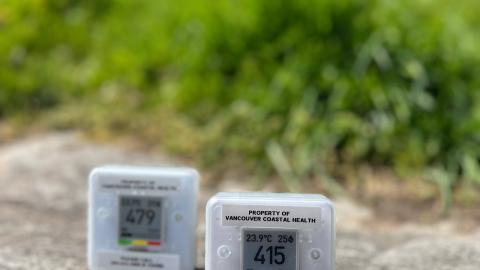Indoor air quality

Canadians spend an average of 90% of their time indoors, so our indoor environment plays an important role in our health. Whether at home, work, or other indoor spaces, understanding the factors that affect indoor air quality can help us take action to improve our indoor environment.
Indoor air quality can be impacted by:
- Moisture build-up, dampness, and/or water leaks
- Inadequate ventilation
- Poorly maintained heating and ventilation systems
- Building materials and furnishings, such as newly installed cupboards, flooring and carpets
- Household cleaning and maintenance products
- Vehicle emissions from attached garages
- Hobbies or activities such as metal or wood-working
- Indoor combustion, including wood-burning fireplaces and gas stoves
- Outdoor air pollution
Indoor air quality can be improved by:
- Controlling the source of indoor air contaminants
- Improving ventilation and/or filtering the air
- Preventing/removing moisture build-up
- Reducing infiltration of outdoor air pollutants to indoors
For more information on indoor air pollutants and improving indoor air quality in your home, please visit Health Canada’s –Air quality and health page.
Ventilation
Ventilation supplies fresh outdoor air to an indoor environment and dilutes or removes stale indoor air. Poorly ventilated spaces can allow indoor air pollutants to build up and potentially impact health. On good air quality days (most days in our region), bringing in outdoor air can dilute the concentration of pollutants indoors.
Ventilation methods such as natural ventilation (e.g., open windows and doors) and mechanical ventilation systems can greatly improve indoor air quality. Different types of mechanical ventilation, such as bathroom fans, kitchen exhaust hoods, and HVAC (heating, ventilation, and air conditioning) systems within a building, allow ventilation and adequate air change rates.
It is important to consider outdoor air quality when using ventilation systems, especially during wildfire smoke events. Outdoor air pollution circulating indoors from wildfire smoke events and traffic can impact indoor air quality substantially. Here are tips to maintain or improve indoor air quality in such circumstances:
- During wildfire events, it is important to increase air filtration and possibly adjust ventilation to minimize the amount of outdoor air entering the indoor space. Potentially adjust ventilation so less outdoor air is moved inside. To ensure optimal air filtration, windows and doors leading outside should be closed. Windows and doors to the outdoors need to be closed for air filtration to be most effective. (For more information, see our wildfire smoke guidance document for schools and childcare facilities).
- For buildings located in an area with poor air quality year-round (such as near a busy road), consider enhancing filtration in the HVAC system to help remove pollution before it comes indoors. (For more information, see our traffic-related air pollution guidance document for schools and childcare facilities).
- For more information on ventilation and CO2, visit our ventilation and indoor air quality guidance document for schools and childcare facilities.
Mould
Mould refers to a diverse group of fungi that can be found both indoors and outdoors. Moisture and warm temperature can promote the growth of mould indoors.
Mould can be found in poorly ventilated areas such as
- Bathrooms,
- Areas with water leaks,
- Behind drywall with moisture build-up, and
- On windows with condensation.
Controlling the sources of moisture and ensuring adequate ventilation is key in preventing mould growth. Mould can be problematic for individuals sensitive to it, as inhaling or coming into direct contact with mould spores can trigger allergic reactions. Those with compromised immune systems or underlying respiratory conditions may experience more severe reactions.
Implementing measures like moisture control, proper ventilation, and regular maintenance can effectively prevent and manage mould, promoting healthy indoor environments.
Learn more about step-by-step guidance on addressing mould growth, when to seek professional help, and how to prevent mould from recurring.






